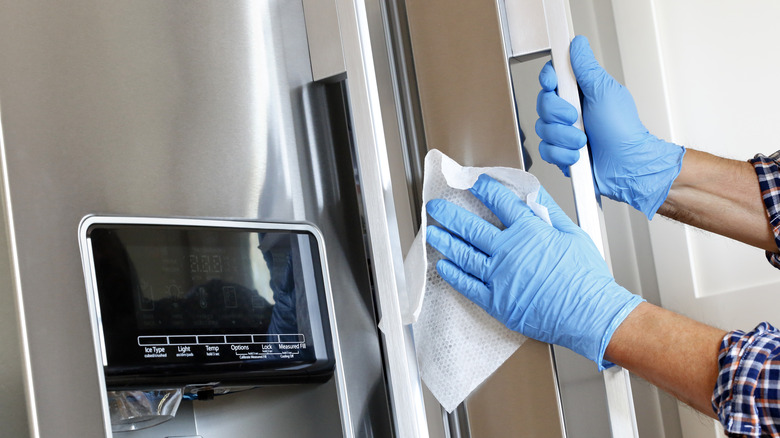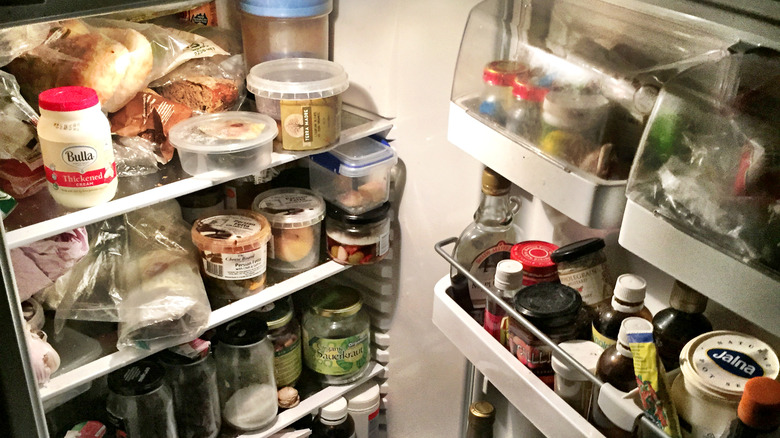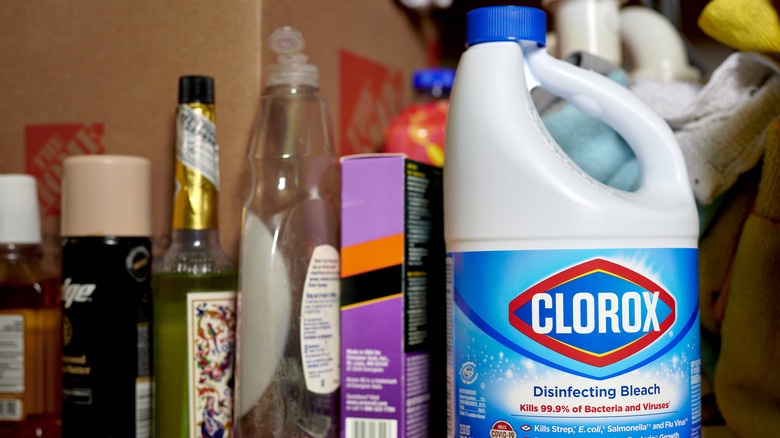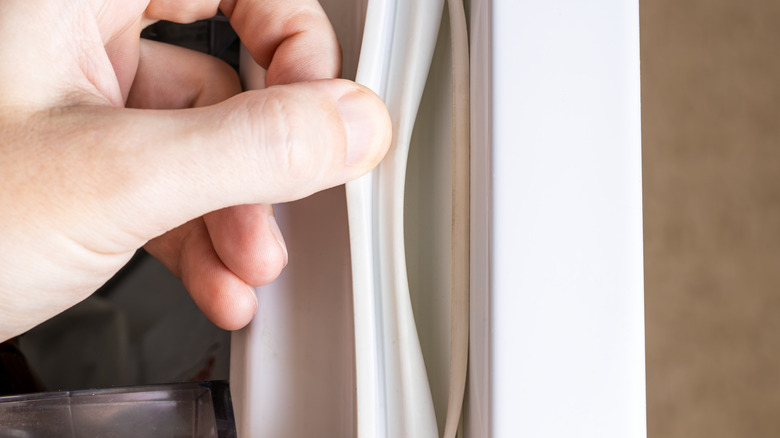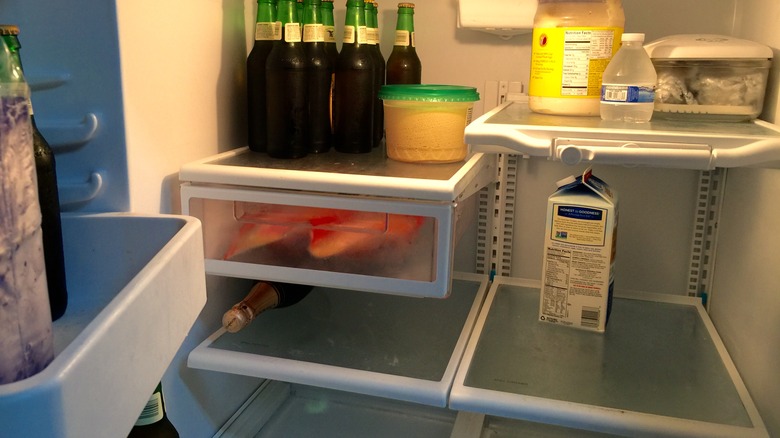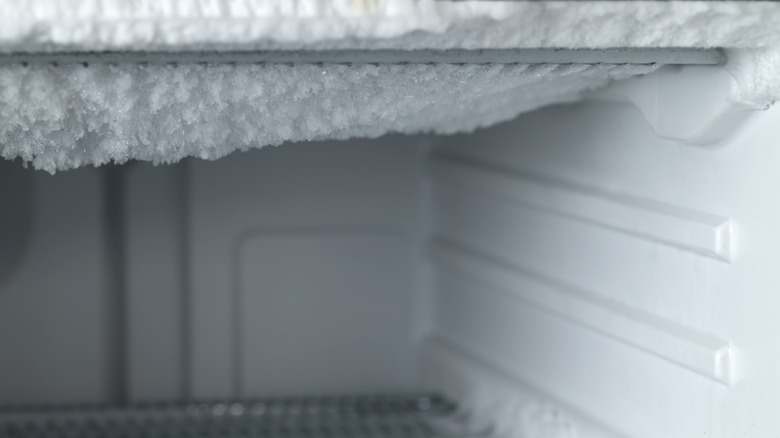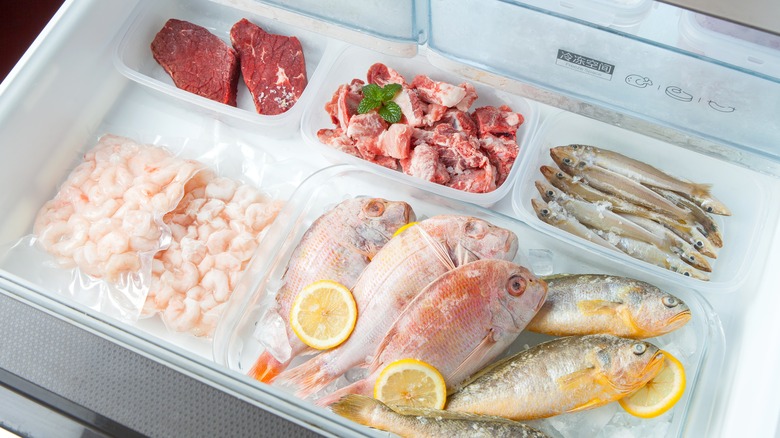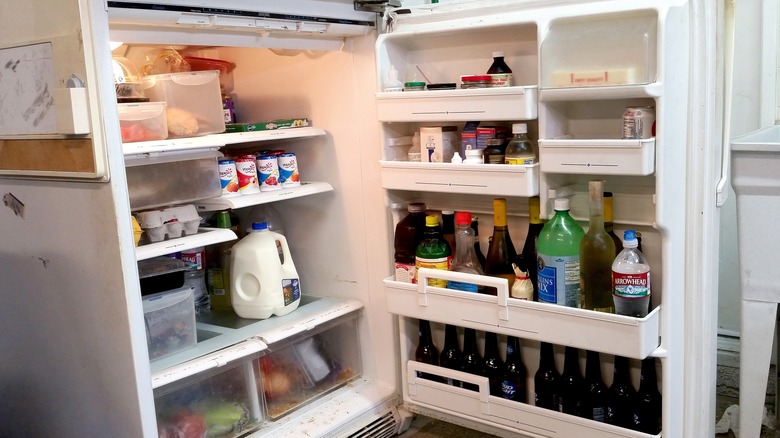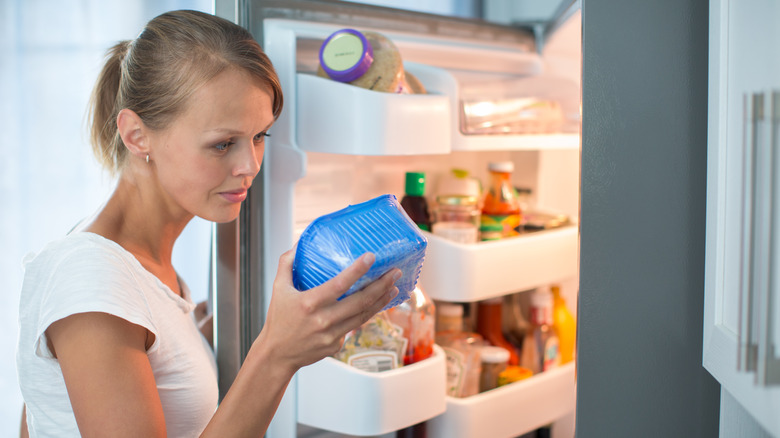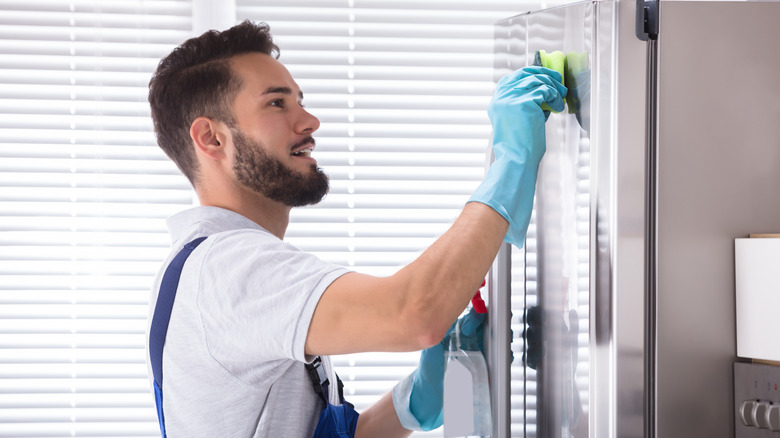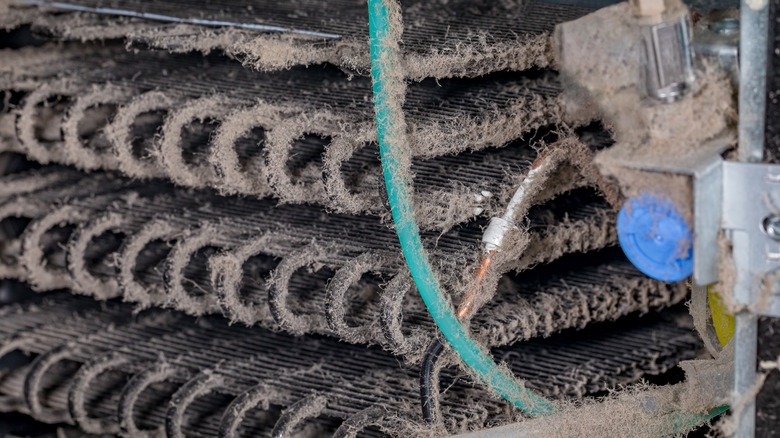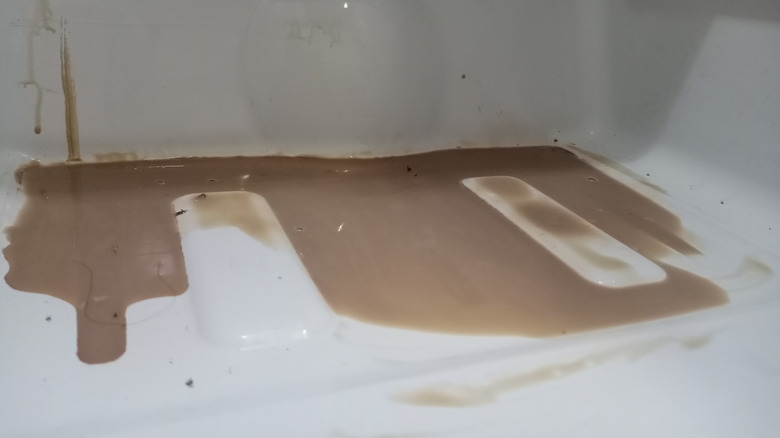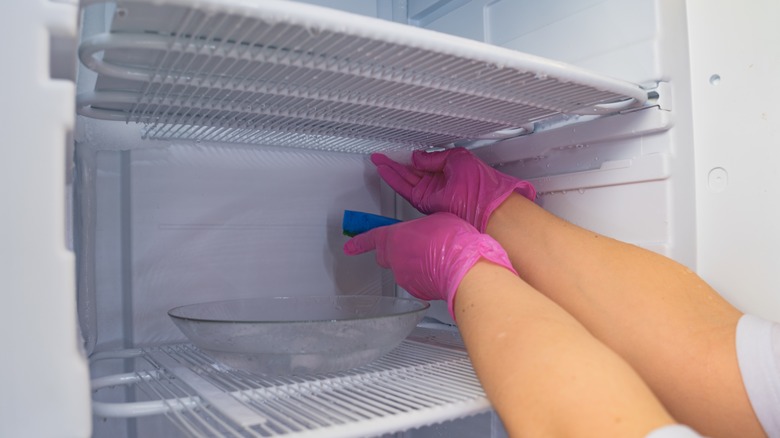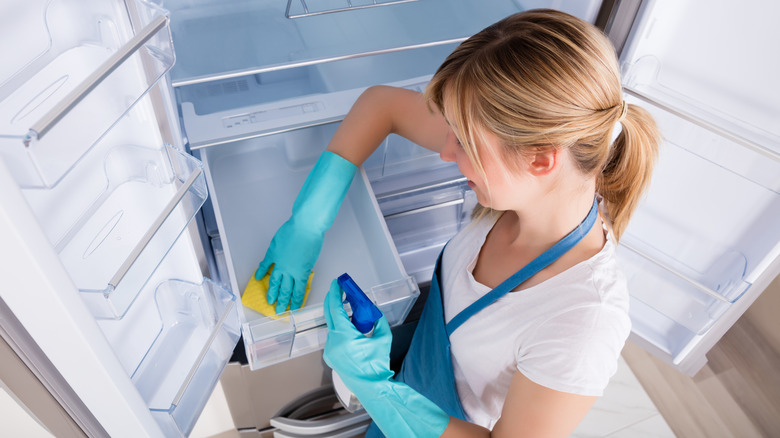Common Mistakes You're Likely Making When Cleaning Your Fridge
Everyone makes mistakes, especially when cleaning their fridge... if they even clean them at all. When dealing with one of the most important appliances in the home, a little regular maintenance can prevent a host of unpleasant surprises – mold, off-putting odors, and even potential health hazards. Even if you are vigilant about throwing out expired sauces or wiping sticky fingerprints off the handle, there is still plenty you are doing wrong when cleaning this appliance.
Did you know you need to defrost your freezer at least once a year? Do you know where your fridge's condenser coils are — and that not dusting them could be the reason behind your outrageous power bill? You might even be using the wrong cleaning supplies, which could even lead to poisoning yourself and your family. If you want fresher food, lower energy bills, and an appliance that lasts for years to come, make sure you're avoiding these common fridge cleaning mistakes.
Neglecting regular cleaning
Things will likely get gross if you wait too long in between fridge cleans. This makes the tidying that you do finally do a lot more work, because the long wait can lead to mold, bad smells, and rotten food. Mold can thrive in the damp and often forgotten corners, posing health risks and making food unsafe. Bad odors can permeate not only the fridge, but can also get into things you plan to eat, affecting their taste and quality even if they haven't been in there for long. Plus, the remnants of spoiled or expired food can contaminate fresh items if they are near each other, potentially leading to more food-borne illnesses.
To avoid this, you should stay on top of cleaning out your fridge. Try planning to give the appliance a quick once-over at least monthly. While this might sound like overkill, you will soon find that a quick clean every 30 days or so is significantly easier (both in effort and in the amount of gross things you have to smell and touch) than leaving it for much longer. Be sure to get rid of leftover food at least once a week.
Not emptying it first
Trying to clean around items in a fridge can be challenging. Too many things in the way can limit your access to all its nooks and crannies. To streamline things, you should start by completely emptying it of all food, drinks, and even your massive collection of half-used sauces. This step allows you unobstructed access to every surface within the fridge, making the cleaning process much more thorough and efficient.
Start by removing all the shelves and drawers, plus any other removable bits, like door bins. This way, you can clean these parts separately, instead of finding rotting food wedged in a door crease weeks later. Use a food-safe spray or a mild mixture of water and vinegar to wipe down all the interior surfaces. This would be the walls, shelves, and drawers. Once they are all out, pay special attention to spots where spills and residues often accumulate, like around the sauce rack.
While the fridge is empty, you should also declutter and organize your food items. Check for expired or spoiled food and throw it away. If you find yourself unable to deal with items that have long since rotten, simply throw the Tupperware container away, too. Sometimes we don't get rid of rotten food because it's too gross. By allowing yourself this workaround, you are more likely to pull off the task.
Using harsh chemicals
It's not a good idea to use harsh chemicals when cleaning your fridge because of the potential contamination of your food. These chemicals, like bleach, ammonia, or other surface cleaners, might leave behind residue that you could ingest if you are not careful. These leftover chemicals can create a health hazard if you eat them; however, they can also just make your food smell and taste like chemicals, which isn't appetizing.
Instead, opt for milder and safer cleaning solutions when working on your refrigerator. A mixture of warm water and dish soap is effective for removing dirt, spills, and odors without leaving any harmful residues. Baking soda is excellent for neutralizing smells, while a mixture of equal parts water and vinegar can help tackle tougher stains and grime. If you want to use a store-bought spray, check the ingredients to make sure it is safe for use in the fridge. Another option would be to wipe the fridge with warm water after cleaning it with chemicals to ensure all traces are washed away. However, these natural alternatives are safe, environmentally friendly, and do not pose risks to your food or health.
Ignoring the door seals
It's a common mistake to ignore the door seals when cleaning your fridge. They are typically out of sight, so you might not think to pay attention to them, but they can accumulate crumbs, sticky spills, and other debris over time. If you don't address this, these trapped particles can not only affect the overall cleanliness of the fridge, but also compromise the effectiveness of the seal — leading to ruined food and high power bills.
This is because a good seal makes sure that the cold air remains inside the appliance, keeping your food at the right temperature and preventing energy wastage. When crumbs and spills build up in the seals, they can create gaps that allow cold air to escape and warm air to seep in. This can lead to higher energy consumption and potential temperature fluctuations inside the fridge. To clean the door seals, use a mild detergent mixed with warm water and a soft cloth. Gently wipe them, paying attention to any areas with visible dirt or debris. Take care not to damage the rubber with abrasive cleaners or excessive force.
Not removing and cleaning shelves and drawers
Yes, it is more work to take out all the shelves and drawers when cleaning your fridge, but it is a mistake not to do so. Start by carefully removing them, as well as the storage bins, from your fridge. Take note of how they fit into the refrigerator, to avoid doing a complex puzzle when you try to put everything in again later. Once removed, wash them with warm, soapy water. This gentle yet effective cleaning solution helps break down spills, stains, and bacteria. Pay close attention to corners, crevices, and edges, as these areas tend to harbor the most gunk.
A soft brush or sponge can be useful in reaching and cleaning these spots. Depending on how dirty they are, you might need to give them a little more elbow grease with a Scrub Daddy, or similar tool. After a good scrub, rinse everything off in the sink to make sure no soap residue remains. Allow them to air dry completely before placing them back in the refrigerator.
Neglecting the freezer
When cleaning your fridge, don't forget to clean your freezer, too. Overlooking its maintenance can lead to reduced efficiency due to ice buildup. Ice accumulation can hinder the freezer's ability to maintain a consistent cold temperature, making it less energy-efficient and potentially compromising the quality of frozen foods. To avoid this, you need to regularly defrost. This is typically at least once a year, or if the ice ever gets more than a quarter of an inch thick.
To defrost everything correctly, it's best to follow the manufacturer's guidelines. A paper copy comes with the appliance, but if you've done the common thing and thrown this away, it's easy to find a copy online by searching the fridge's make and model. However, the process typically involves unplugging the appliance, removing all items, and allowing the ice to melt naturally. For a quicker defrosting process, placing bowls of hot water inside and gently directing a fan toward the area can expedite the melting of ice. Once defrosted, you can carefully wipe down the interior with a mixture of warm water and mild detergent. Pay special attention to corners and crevices where moisture and ice can accumulate. Dry the interior thoroughly before plugging the freezer back in and restocking it.
Storing uncovered food
If you don't cover food when you store it in your fridge, it not only invites spills, but also allows odors to permeate and linger, affecting the overall freshness of other items stored nearby. If you don't want your apple slices smelling (and tasting!) like cooked chicken, you need to cover things up. So, invest in airtight containers for storing leftovers, fresh produce, and any other "open" food items you intend to keep in the fridge. These containers provide an effective seal that not only helps in preserving the freshness of the food but also prevents any potential messes. Airtight containers come in various shapes and sizes, so you don't need to worry that food is too big or too small for them. They even come in fun colors and themes, too.
To avoid making more work for yourself, make sure they are completely sealed. This stops any air from entering, which prevents the chance of bacterial growth, thus helping to maintain the taste and quality of the food. You should also label the containers with the date of storage, so you know for sure when you cooked them. This will help you avoid eating food that's been in storage too long, as well as know what to throw away when you clean your fridge.
Overloading shelves
If you can close the door to your fridge after you clean it, you might think all is well. Unfortunately, if you have crammed every shelf full of food and condiments, you might run into a few problems. Simply put, putting too much stuff into this appliance can mess up the airflow. This makes things cool unevenly as the circulation is blocked, which can then in turn cause bad smells. Instead, when cleaning, make sure you leave some space between items to let the air move and keep the fridge at a steady temperature. This way, your food will stay fresh, and the weird smells won't spread to everything else.
If your fridge is on the smaller side, you can maintain enough room by prioritizing eating leftovers to cut down on storage containers. You can also take a picture of the sauces you already have, so you don't overbuy replacements during your next shop.
Ignoring expiration dates
Ignoring expiration dates on food items in your fridge is a common oversight. It impacts both the cleanliness and safety of your refrigerator. All food can spoil over time and consuming expired items can pose health risks. Beyond food poisoning, old and expired foods tend to emit unpleasant odors that can spread throughout the fridge. These smells are quite strong and affect the taste and freshness of other items.
To avoid this issue and maintain a clean and odor-free appliance, make it a habit to regularly check expiration dates on food packaging. Take the time to thoroughly inspect items foods like dairy products, meat, and packaged goods, which often have clear expiration or "use by" dates. By staying vigilant about expiration dates, you can maintain a cleaner and more organized fridge. You can also avoid the disgusting smells and difficult textures of expired food. On occasion, the worse something gets, the more we avoid doing it, so nip things in the bud and get rid of "off" food early.
Not cleaning the exterior
When you think about cleaning your fridge, you typically only think about freshening up the inside. However, this is a mistake. Of course, it's important to maintain the interior for food safety, but paying attention to the exterior is equally vital. Over time, the appliance's outside parts, like the handles, control panels, and even the top of the fridge, can accumulate dust, grime, fingerprints, and even food spills.
To make sure to avoid attracting bugs and to maintain an overall tidy kitchen, be sure to include the exterior in your routine. Just like on the inside, you can use a mild cleaning solution or a mixture of warm water and dish soap. Next, dampen a cloth and thoroughly wipe down the outside. Pay special attention to the handles, as they are commonly touched areas and can harbor germs. Next, gently wipe the control panels. Be careful to make sure no cleaning solution seeps into the electrical components of these. For stainless steel finishes, consider using a cleaner specifically designed for that type of appliance to maintain its shine and prevent streaks. Finally, you can periodically dust the top and sides of the fridge to prevent buildup and maintain a nice, polished look.
Skipping the condenser coils
Skipping the cleaning of your refrigerator's condenser coils is a commonly overlooked maintenance task that can significantly impact the efficiency and lifespan of your appliance. The condenser coils, located either at the back or underneath the fridge, play a critical role in cooling the refrigerator. However, they tend to accumulate dust, pet hair, and other debris from the surrounding environment. This buildup acts as insulation, preventing the coils from dissipating heat effectively and forcing the refrigerator to work harder to maintain the desired temperature. As a result, the efficiency of your fridge diminishes, leading to higher energy consumption and potentially shortening its lifespan.
It's a common mistake to skip cleaning them because most of us forget they are even there. Remember to check in on them about twice a year, at least. Start by locating the coils, which are typically either at the back behind a panel or accessible from the front underneath a kick plate. Using a vacuum cleaner with a brush attachment or a coil cleaning brush, carefully remove the accumulated dust and debris from the coils. Gently brush or vacuum in the direction of the fins to avoid damaging them. Take care not to bend the coils during this process. If you prefer, you can unplug the fridge before you begin for safety. This task should take no more than a few moments, so when you turn the fridge on again, your food should not be harmed.
Ignoring spills for too long
When something spills inside the fridge, it can be tempting to just shut the door and deal with it later. However, letting these spills linger in your fridge can lead to stubborn stains and odors. Instead, you should address accidents right away to prevent them from becoming harder to clean. This is because the longer something sits, the longer it has to seep into the pores of the refrigerator's surfaces. Immediate action is also a good idea to prevent things from getting too stinky, as these incidents often harbor bacteria. This will cause unpleasant smells and potentially contaminate other foods, too.
While it is a little more work, as soon as you notice a spill, take a few minutes to clean it up. Often, you don't even need a cleaning solution to wipe up something fresh. Instead, a wet sponge or paper towel will do the trick.
Not drying surfaces thoroughly
Taking one extra step when cleaning your fridge can save you from bigger headaches later on. When you have cleaned all the removable bits and interior with soap and water, you need to dry everything off, too. Even after using cleaning agents, moisture tends to remain on surfaces inside the appliance. This provides an environment that's perfect for mold and bacteria to thrive in. Both of these can pose health risks and contaminate the air and food in your fridge.
To avoid them, you can use a dry and fresh cloth to absorb any remaining moisture from the inside. A paper towel or two also works in a pinch. You should pay particular attention to crevices, corners, and seals where moisture tends to accumulate. Even though it adds a few minutes to the task, maintaining a dry fridge contributes to the longevity and safety of the food you consume.
Forgetting to unplug the fridge
Sometimes for a deep clean, the fridge should be disconnected from the electricity for your safety. This is the case if the appliance is full of rotting food or has been years since its last cleaning.
To start, prepare for the deep clean by removing any perishable items from the fridge and placing them in a cooler with ice packs. This precaution helps maintain the temperature and freshness of your food during the cleaning process. Next, locate the power cord and the electrical outlet powering the refrigerator, usually positioned at the back. Turn off the fridge using the control panel or temperature settings, and gently unplug the power cord from the outlet. If the outlet is hard to reach, carefully move the refrigerator to access it. This might be a two-person job, as the appliance tends to be heavy and awkward. Allow a few minutes for the internal components to power down completely and for any residual electric charge to dissipate before proceeding with the cleaning. After ensuring all surfaces are dry, wait a few minutes before plugging the refrigerator back in.
